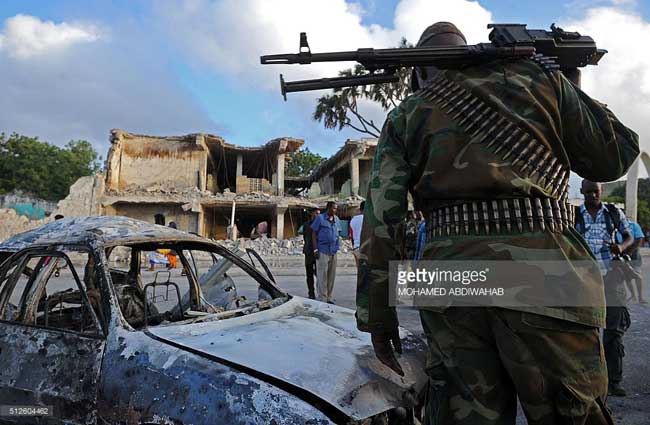‘We’re Finding It Difficult to Hold’ Territory in Somalia: Senator Reed
Not much has changed about Somalia’s prospects for long-term stability, says Sen. Jack Reed, since he first visited the streets of Mogadishu almost 25 years ago. Reed, now the top Democrat on the Senate Armed Services Committee, visited the country anew last week. He found that although the 500 U.S. troops there are effectively disrupting the extremist group al Shabaab, he said, the Somali government is still struggling to hold territory, even with the help of international partners.
“Our doctrine is…to disrupt, clear, hold. We’re finding it difficult to hold,” the Rhode Island senator said. “We have specialized units who are very good at disrupting al Shabaab together with our special operators, but we’re certainly not at the ‘clear and hold phase,’ we’re at the phase of disrupting al Shabaab, keeping them off balance.”
The Pentagon says American troops are in the country to foster a secure environment and deter groups like al-Shabaab and the smaller Islamic State contingent.
So the U.S. ramped up its air war in Somalia last year, after President Donald Trump gave commanders more latitude to call in air strikes“within a geographically-defined area of active hostilities in support of partner forces.” In 2017, U.S.Africa Command conducted more than 30 strikes in Somalia, more than four times the average over the previous seven years.
Reed said al Shabaab was being undermined by various factors, including those strikes and other direct actions, which have removed “key leaders and external plotters from the battlefield.” But the extremist group still conducts suicide bombingsand mortar attacks in and around the capital city daily. A particularly horrific truck bombing, which no group has yet claimed, killed 500 people in October.
“In terms of building a stable entity, a country that can take care of its own forces, that’s a long way off,” Reed said.
Two main challenges: The Somali national government, dogged by corruption and beset by political tension with the states, is largely unsupported by the population and lacks an army trained well enough to hold territory outside the cities. AFRICOM estimates that 3,000 to 6,000 Al Shabaab fighters and a couple hundred Islamic State fighters operate in the country.
“Outside of Mogadishu, there’s not a real presence of the federal government,” Reed said. “The government is perceived by many people as corrupt and not serving their ends.”
Meanwhile, the international group of African forces that helped recapture Mogadishu and maintain the modicum of stability since, the African Union Mission in Somalia, or AMISOM, has been less active since a string of deadly brushes with al Shabaab, Reed said.
“We’re finding it difficult to hold because the AMISOM countries have pulled back a bit, they’re more located on forward-operating-bases, they’re not going out a lot,” he said. “They seem to have reached the point where they’re not going to take on any additional roles and al Shabaab has kind of rebounded.”
AMISOM also started withdrawing troops, aiming to shift security responsibilities to the Somali army by 2020. That hasn’t generally affected U.S.operations, a Pentagon spokesperson said, but trying to do so too soon could.
“The long-term stability in the country will depend on how a withdrawal of AMISOM is conducted and highlights the importance of a well-thought out, conditions-based hand-off between Somali National Security Forces and AMISOM,” said Pentagon spokesperson Maj. Sheryll Klinkel.
Leaders from the AMISOM nations met in Uganda Friday to discuss the transition and security strategies during it. One key question: Are the Somali National Armed Forces ready to be in the lead?
“Right now there’s an effort to build up a Somali National Army, but it’s involved in the political fight between the federal government and states,” Reed said. Plus, there’s other questions about their caliber: “It’s who’s training them? When I was there I was told the Turks had come and trained two battalions of the Somali National Army, but to what standards?”
If AMISOM does pull out, could that role inevitably fall to the U.S., of train, advise, and assist fame? Reed says that’s not something he sees an appetite for.
“We train some specialized units, but I think the notion of going in, like what was done in Afghanistan, to try to train a national army that will fully replace — I don’t think that’s on the table,” he said. “That has to be done, but maybe it could be done by somebody else, maybe we could participate in doing it, but taking that on as we did in Afghanistan or as we did in Iraq?”
And like Afghanistan, building a capable military in Somalia is only just one necessary step within a larger stabilization effort. After decades of instability and limited governance, the Somali government “faces significant work ahead to help Somalia recover,” Klinkell said.
“Twenty-five years ago getting off the airplane in Mogadishu, it was a complicated situation and even back then, we said, ‘Well the real key here is developing governance — the capacity to govern, to generate a sense of internal support by the people for their government. That is probably the best way to defeat any type of terrorist movement,’” Reed said. “We’re still trying to find that.”
Source; Defense One

